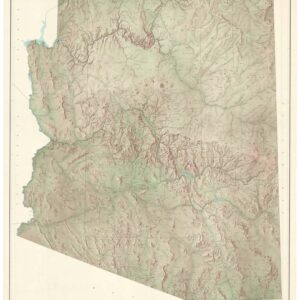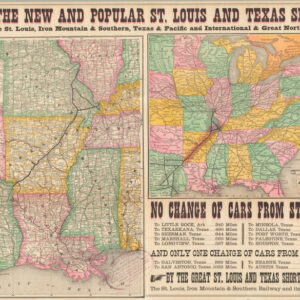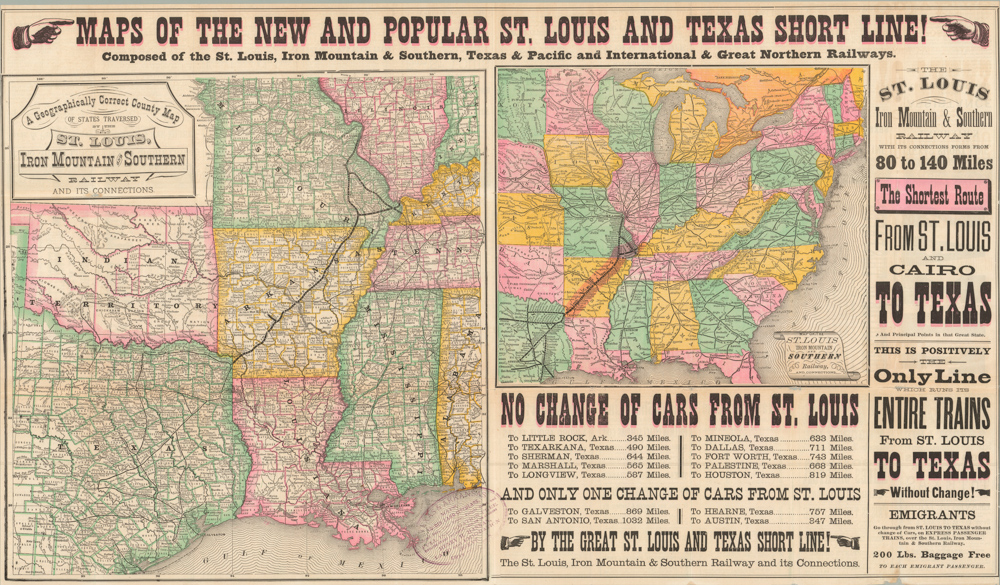A highly artistic broadside for the visionary Dallas-Fort Worth Airline Boulevard: a Depression-era infrastructure project designed to bridge and unite two Texas cities.
“As the Crow Flies” A 200-Ft. “Airline” Boulevard Between Fort Worth and Dallas
$2,900
1 in stock
Description
This is a difficult piece to categorize. It hovers somewhere between a map and an artistic promotional poster, and is perhaps best classified as a bird’s-eye-view. It has been embedded with a very obvious and explicit intent, an art as old as mapmaking itself. Nevertheless, there is something distinctly fresh about this cartographic rendition, emphasizing that it is the brain-child of a time marked by both the social and economic consequences of the Great Depression, but also by a technology-driven optimism that envisioned humankind at the threshold to a new and better era.
Essentially, this highly artistic map shows the 32-mile stretch between Fort Worth and Dallas, as well as the surrounding landscape. The area between the two cities is highlighted by a thick and bright yellow line that represents a proposed massive 8-lane highway, which would link the two cities and increase their commercial interaction and combined potential. The purpose of this rare poster was essentially to promote its construction and convince viewers of its many benefits. This was necessary in the 1930s, as the multi-lane freeway was still a concept in its infancy back then. Similarly, the presence of a Ford Trimotor airplane overflying the route, hints at the potential for commercial air traffic even over shorter distances. Despite being a visionary idea, the project was never realized; likely the Depression played its part in shelving the plans. In the end, the Fort Worth – Dallas turnpike only became a reality in the mid 1950s; ironically at roughly the same time that airlines introduced the first domestic commercial routes.
The map image itself only takes up about half of the poster, which in total measures 31 by 21.5 inches (79 x 55 cm). It was drawn by C.K. Chambers of Southwestern Engraving Co. and was lithographed by Utter & Evans, both in Fort Worth. The substantial amounts of text on the poster provide us with a wealth of background information on this project. Among the things we glean from its content is that the driving force behind the idea seems to have been W.F. White, Chairman of Fort Worth’s Highway Committee. The broadside does not provide us with a date for its publication, but consistently refers to the prospect of completing the project by the 1936 Centennial (in reference to the Texas Revolution). Logically, this presumes that it was compiled and printed some years in advance.
Below the headlines and poignant image, we find a short essay highlighting the foreseen outcomes of this project. We leave it to the viewer to study this text as a whole, but have extracted some of the points below, as these resonate broadly with the development of America’s suburbia in the 20th century, and thus constitutes a testimony to our country’s heritage.
- The 200-foot wide boulevard will give suburban construction impetus and result in a continuously developed area between the two cities, creating homes and communities in the process.
- The inter-urban space will be ideal for attracting ‘great industries and enterprises of all kinds to the territory traversed’. Soon, the project will convert the area into ‘one splendid, continuous, highly developed section adding large taxable values to both counties’.
- It increases motor traffic safety significantly, but also enhances the travel experience, making it faster, easier, and more comfortable.
- The freeway is planned to connect the two cities’ business centers, promoting commercial interaction and limiting the hassle and noise associated with traffic in domestic areas.
- Uniting commercial interests will foster better relations between the inhabitants of the two cities.
- And finally, we are provided with some alarming statistics to underline the sheer necessity for thinking out of the box. From the figures, we learn that no less than 25,367 automobiles and trucks were checked through the East Front Street underpass in Fort Worth over the course of a 12 hour period.
One cannot but recognize the vision behind this poster and the initiative that it represents. Connecting large urban areas by massive freeway systems was not only a great stimulus of economic growth and demographic mobility, but also significantly increased traffic safety for urban inhabitants, as regular roads were alleviated of the ever increasing traffic burden. It was a visionary idea, years ahead of its time, and reminds us that much of America’s drive and innovation in the 20th century originated in the vast expanse between her two coasts.
Cartographer(s):
The Southwestern Engraving Co. was a major commercial engraver based in Fort Worth Texas. During the 1920s the company experienced significant success producing lithographed commercial posters and advertisements. Despite having their main base in Fort Worth, the company had outlets in Houston, Dallas, Wichita Falls, Tulsa, and Atlanta as well. C.K. Chambers worked for the Southwest Engraving Co. in their main offices in Fort Worth.
Condition Description
A few small losses at the edges, as illustrated. Two tears repaired with archival tape.
References





